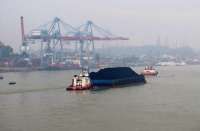JAKARTA. State-owned airport operator Angkasa Pura II (AP II) is set to operate three more commercial airports this year in a bid to help boost economic development across the country.
AP II corporate secretary Trisno Heryadi said the airports to be managed by the firm were Radin Inten II Airport in Lampung, Silangit Airport and Kuala Namu International Airport, both in North Sumatra.
“We are going to further develop the airports in the future so that they can accommodate every type of aircraft, including wide-body [aircraft]. This will help more flight services enter those regions, resulting in better economic development,” Trisno told The Jakarta Post on Monday.
Unlike Kuala Namu, Radin Inten II and Silangit are not new airports. They used to be managed by the Transportation Ministry’s technical operation unit.
“For Radin Inten II, we expect to begin operations very soon,” he said.
Trisno added that the firm was committed to upgrading Silangit to an international class airport in order to support North Sumatra’s tourism sector, given that the airport was close to one of the country’s most popular tourist spots, Lake Toba.

He said that AP II was currently calculating the investment required to expand the airport’s terminal and runway this year.
In a bid to accommodate larger aircraft, the firm will widen the width of Silangit’s runway from 30 to 40 meters.
The new Boeing series, including the B737-800 Next Generation and the B737-900 Extended Range that are operated by most domestic and international carriers, require a runway width of at least 40 meters.
The firm, however, does not plan to extend the length of the runway immediately because it had reached 2,250 meters, long enough for bigger planes to land, he said.
In addition, Trisno said that Silangit Airport’s development was crucial because the airport was expected to help support Kuala Namu International Airport in Deli Serdang regency, which would begin operations next month.
Passenger traffic to Medan reached almost 7 million last year, while Kuala Namu will cater to 8.1 million passengers in March, forcing the firm to find a short-term solution to accommodate more passengers before further expanding the new airport.
Moreover, he said that AP II was going to enter the hospitality and cargo industry to help increase the firm’s revenue this year.
“We have recently set up a business unit to develop the cargo and hotel sectors. The unit is finishing its programs and there is a possibility that we will work with a third party to develop the sector,” he continued.
For the hotel industry, he said that the firm planned to open budget to upscale accommodation to secure a whole market segment.
He said that AP II lost its navigation assets and a chunk of revenue from airlines after the government established a new state-owned company to manage national air traffic control services — namely the Indonesian Air Navigation Services Organization (PPNPI) in January.
The PPNPI was the result of a mandate from the 2009 Aviation Law, which authorized the government to transfer air navigation service management from airport operators to a non-profit institution to improve the nation’s air traffic services. (Nurfika Osman/ The Jakarta Post)
/2012/02/01/266793417p.jpg)









